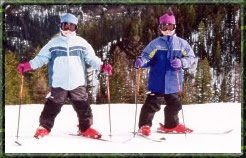
Let's talk briefly about ski safety today...
130,000 kids are injured every year in snow ski related accidents and most deaths while skiing can be attributed to head injuries....Lesson 1....Wear a Helmet.
Skiing injuries are on the increase, but by using a helmet you can reduce your rate of injury by about 53% say the experts...Lesson 2..... Wear a Helmet. Check out Lids on Kids.org at www.lidsonkids.org for more info on this important topic.
Most if not all ski areas are in more remote locations and have volunteer ambulance corps that respond to emergencies...some mountains might have professional crews on site already during peak times....some mountains may have more extensive first aid capabilities....some may not.
When was the last time you sent your kid off skiing/boarding assuming emergency crews or hospital ER staff knew how to contact you or another relative in the event of a serious injury? Sometimes the nearest hospital itself may be 30-60 minutes out....if you are still thinking about it, you might recall from earlier blogs that on average it takes 5 hrs and 51 minutes for someone (you) to be notified in the event of an emergency....now these folks on ski patrols are a pretty sharp bunch no doubt...and are there in a snap doing what they train repeatedly to do and are right there skiing on the mountain....but they could also benefit from your being more prepared.
If your school ski program has you fill out a liability waiver and emergency medical/contact info sheet that someone else inevitably carries with them on the ski trip...wouldn't it be a better idea to have each child also carry ICE info on their person?
130,000 kids are injured every year in snow ski related accidents and most deaths while skiing can be attributed to head injuries....Lesson 1....Wear a Helmet.
Skiing injuries are on the increase, but by using a helmet you can reduce your rate of injury by about 53% say the experts...Lesson 2..... Wear a Helmet. Check out Lids on Kids.org at www.lidsonkids.org for more info on this important topic.
Most if not all ski areas are in more remote locations and have volunteer ambulance corps that respond to emergencies...some mountains might have professional crews on site already during peak times....some mountains may have more extensive first aid capabilities....some may not.
When was the last time you sent your kid off skiing/boarding assuming emergency crews or hospital ER staff knew how to contact you or another relative in the event of a serious injury? Sometimes the nearest hospital itself may be 30-60 minutes out....if you are still thinking about it, you might recall from earlier blogs that on average it takes 5 hrs and 51 minutes for someone (you) to be notified in the event of an emergency....now these folks on ski patrols are a pretty sharp bunch no doubt...and are there in a snap doing what they train repeatedly to do and are right there skiing on the mountain....but they could also benefit from your being more prepared.
If your school ski program has you fill out a liability waiver and emergency medical/contact info sheet that someone else inevitably carries with them on the ski trip...wouldn't it be a better idea to have each child also carry ICE info on their person?
If the school monitors are out of communication ( real easy) with the ski patrol or the lodge office when they find your child...why waste time? Got special medical needs....maybe your child has an alert bracelet that requires you to call an 800 number...more delay....RFID chips?....okay you have them built into your North Face Jacket but that's great if you are lost in an avalanche....not too many of those out east....and if they work.....
Lesson 3 ....Get you school ski club or ski hill to Sponsor ICE and give out the stickers and cards so everyone is on the same page - like how much is this going to cost.....about 20 cents each. Add in a few lessons about the National Ski Patrol's Resonsibility Code at www.nsp.org/1/nsp/safety_information/yourresponsibilitycode.asp
Lesson 3 ....Get you school ski club or ski hill to Sponsor ICE and give out the stickers and cards so everyone is on the same page - like how much is this going to cost.....about 20 cents each. Add in a few lessons about the National Ski Patrol's Resonsibility Code at www.nsp.org/1/nsp/safety_information/yourresponsibilitycode.asp
For sure...take some time and get more acquainted with your school's safety procedures while on the mountain and how those entrusted with your child's safety are trained to respond in an emergency.....and learn more about the relationship between the mountain and the Ski Patrol itself.....or become a Ski Patroller - an investment in time but a good one (if you like to ski).
Plenty of time left this season....have some fun knowing you're a bit more prepared.....In Case of Emergency.
No comments:
Post a Comment
Want to comment on this blog? Please submit comments that pertain to the subject matter if you would be so kiind. Approved comments will be posted as soon as possible. Thank you.